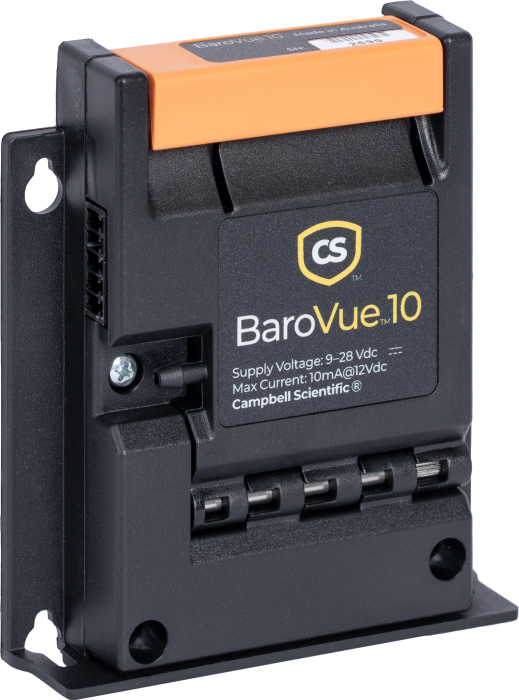Resumen
The BaroVue™10 is a highly accurate barometer that can measure pressures over a range of 500 to 1100 hPa and can be used in a range of applications that includes meteorology and hydrology. This sensor includes our zero downtime recalibration. Other sensors on the market need to be taken offline and sent back to the manufacturer to be recalibrated, often for weeks at a time, causing a loss in valuable data and time, as well as an additional expense.
The sensor card for the BaroVue 10 is pre-calibrated. Replacement sensor cards are also pre-calibrated, requiring only one trip to the field station and no downtime. The design of the BaroVue 10 allows you to remove and replace your sensor card quickly and easily without either having to disassemble the equipment in the enclosure or having to send the equipment back to the manufacturer.
Leer másVentajas y características
- Highly reliable measurements (multiple cells)
- Direct-to-digital measurements
- Very low noise
- Integrated identification and diagnostics
- Zero downtime/recalibration
- Easy firmware updates
- Cost effective
- SDI-12 device
Imágenes








Descripción detallada
The BaroVue 10 is a low-power, digital barometer (-40 to +60°C) that provides best-in-class accuracy and stability (±0.1 hPa/yr) over the entire pressure and temperature range. It can run continuously and does not require power cycling unlike other products in this category. The digital output is both SDI-12 and RS-232, which reduces noise and measurement uncertainty compared with analog sensors, and makes the BaroVue 10 compatible with all Campbell Scientific SDI-12 devices. Moreover, this barometric pressure sensor can be installed and integrated into many new and existing weather stations. The transducers used in the BaroVue 10 are direct-to-digital sensors, and no reconversion takes place inside the barometer.
Productos similares
Preguntas frecuentes
Número de FAQs relacionadas con BaroVUE10: 2
-
The calibration sheet supplied with your BaroVue 10 applies to the sensor card (BVC10). The serial number on the outside of the unit refers to the serial number of the BaroVue 10 main board. To confirm you have the correct calibration sheet, please open the device and check the serial number on the BVC10 sensor card itself.
-
A CS106 Barometric Pressure Sensor can be added to the station. However, the sensor needs to be wired into the wiring terminal inside the enclosure, and the data logger program needs to be edited to include the instructions to poll the sensor and store the values.
Note: Some versions of the ET107 station that are interfaced with irrigation companies may have proprietary programs or complicated programs that are not easily changed.
Compatibilidad
Nota: lo siguiente muestra información de compatibilidad notable. No es una lista de todos los productos compatibles.
Dataloggers
| Producto | Compatible | Nota |
|---|---|---|
| Aspen10 | ||
| CR1000 (retired) | ||
| CR1000X (retired) | ||
| CR300 (retired) | ||
| CR3000 (retired) | ||
| CR310 | ||
| CR350 | ||
| CR6 | ||
| CR800 (retired) | ||
| CR850 (retired) |
Miscelaneo
| Producto | Compatible | Nota |
|---|---|---|
| DAQ Case 15 |
Información de compatibilidad adicional
Especificaciones
| -NOTE- | These specifications assume the recommended desiccation is used. |
| Pressure Range | 500 to 1100 hPa |
| Temperature Range | -40° to +60°C |
| Supply Voltage | 9 to 28 Vdc |
| Elevation | ~609.6 m (2,000 ft) below sea level (as in a mine) to 4,572 m (15,000 ft) above sea level |
| Current Consumption |
|
| Digital Output | SDI-12, RS-232 serial |
| Pressure Fitting | Barbed fitting for 0.318 cm (0.125 in.) |
| Dimensions | 2.2 x 9.0 x 10.2 cm (0.87 x 3.54 x 4.02 in.) |
| Weight | 226.8 g (0.5 lb) |
Accuracy |
|
| Calibration Uncertainty | ±0.15 hPa |
| Uncertainty | ±0.3 hPa (at 20°C) |
| Total Uncertainty | ±0.5 hPa (at -40° to +60°C) |
| Long-Term Stability | ±0.1 hPa/yr |
| Power Supply Rejection | Negligible |
| Measurement Noise | 0.05 hPa (RMS) |
| Resolution | 0.1 hPa |
Documentos
Folletos producto
Documentos técnicos
Conformidad
Descargas
BaroVue10 Program Example (1 KB) 28-03-2023
Description: Includes an SDI-12 example and a RS-232-serial program example. The programs are written for a CR1000X, but programs for other data loggers will be similar.
The SDI-12 example uses the C1! command to retrieve data. The program also adjusts the barometric pressure measurement to sea level. The adjustment is entered as a constant, Elevation_m, at the beginning of the program. Initially, the Elevation_m value is 1382; change this value to your site elevation, in meters.
The serial program demonstrates using RS-232 mode to initiate and return measurements using the SerialOut(), SerialIn(), and SplitStr() CRBasic instructions.












